
Am Fam Physician. 2011;83(7):819-826
A more recent article on stable coronary artery disease is available.
Author disclosure: Nothing to disclose.
All patients with stable coronary artery disease require medical therapy to prevent disease progression and recurrent cardiovascular events. Three classes of medication are essential to therapy: lipid-lowering, antihypertensive, and antiplatelet agents. Lipid-lowering therapy is necessary to decrease low-density lipoprotein cholesterol to a target level of less than 100 mg per dL, and physicians should consider a goal of less than 70 mg per dL for very high-risk patients. Statins have demonstrated clear benefits in morbidity and mortality in the secondary prevention of coronary artery disease; other medications that can be used in addition to statins to lower cholesterol include ezetimibe, fibrates, and nicotinic acid. Blood pressure therapy for patients with coronary artery disease should start with beta blockers and angiotensin-converting enzyme inhibitors. If these medications are not tolerated, calcium channel blockers or angiotensin receptor blockers are acceptable alternatives. Aspirin is the first-line antiplatelet agent except in patients who have recently had a myocardial infarction or undergone stent placement, in which case clopidogrel is recommended. Anginal symptoms of coronary artery disease can be treated with beta blockers, calcium channel blockers, nitrates, or any combination of these. Familiarity with these medications and with the evidence supporting their use is essential to reducing morbidity and mortality in patients with coronary artery disease.
Stable coronary artery disease (CAD) is defined as an established pattern of angina pectoris, a history of myocardial infarction (MI), or the presence of plaque documented by catheterization.1 CAD results when coronary artery plaque develops, reducing the oxygen supply to the myocardium. All patients with stable CAD require medical therapy to alleviate symptoms, prevent cardiovascular events, and reduce mortality. Almost 17 million patients in the United States have stable CAD, and nearly 800,000 more will experience an initial event each year. Although CAD caused one out of five deaths in 2005, improved management of the disease has achieved a 34 percent decline in CAD mortality since 1995.1 This article focuses primarily on optimal drug therapy for CAD; other aspects of CAD management, such as coronary revascularization and treatment of comorbidities (e.g., diabetes mellitus), will not be covered here, although lifestyle modifications are briefly summarized in Table 1.2,3
| Clinical recommendation | Evidence rating | References | Comment |
|---|---|---|---|
| Statin therapy should be used to achieve a low-density lipoprotein cholesterol level of 70 to 100 mg per dL (1.81 to 2.59 mmol per L) in patients with coronary artery disease. | A | 3, 8 | Recommendations from evidence-based guidelines3 and metaanalysis8 |
| The low-density lipoprotein cholesterol level should be lowered before attempting to improve the triglyceride or high-density lipoprotein cholesterol level. | A | 2, 3, 13 | Evidence-based guidelines2 ,3 and randomized controlled trial13 |
| Beta blockers should be considered first-line antihypertensive agents in patients with coronary artery disease. | A | 20 | Recommendations from evidence-based guidelines |
| Angiotensin receptor blockers should be used only if an angiotensin-converting enzyme inhibitor is not tolerated. | A | 18, 28–30 | Evidence-based guidelines18 and randomized controlled trials28 –30 |
| Aspirin shows a similar cardiovascular benefit with dosing at 50 mg versus 300 mg per day. | A | 37 | Meta-analysis |
| In patients with stable coronary artery disease, aspirin should be used instead of clopidogrel (Plavix) to prevent further cardiovascular events. | A | 38, 39 | Randomized controlled trials |
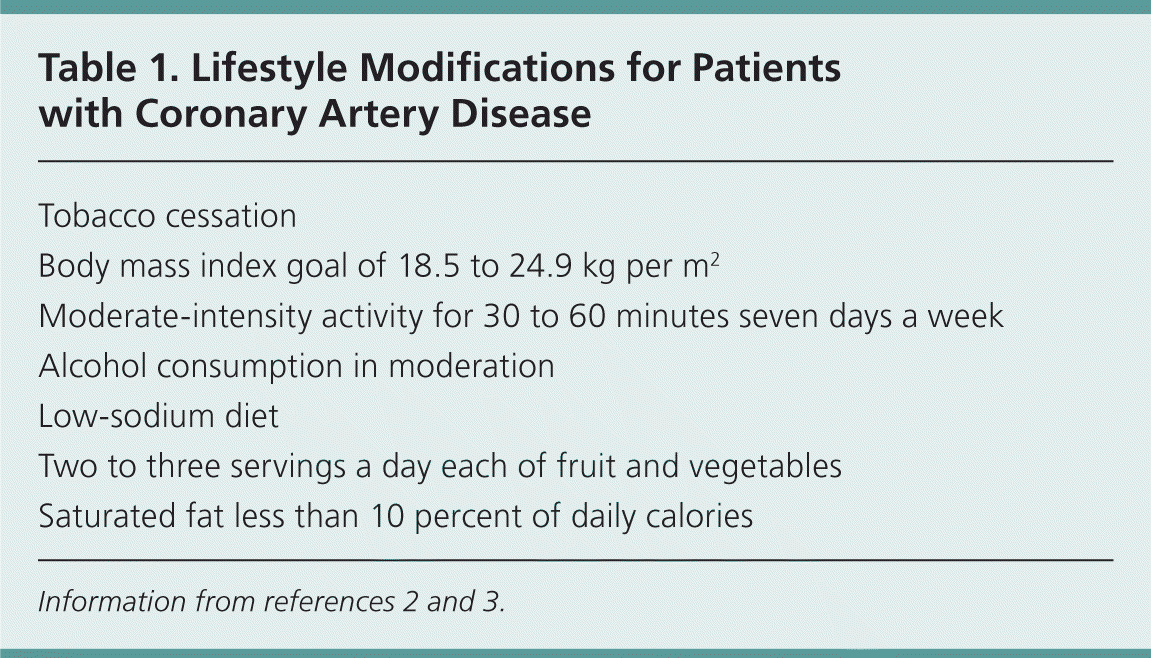
| Tobacco cessation |
| Body mass index goal of 18.5 to 24.9 kg per m2 |
| Moderate-intensity activity for 30 to 60 minutes seven days a week |
| Alcohol consumption in moderation |
| Low-sodium diet |
| Two to three servings a day each of fruit and vegetables |
| Saturated fat less than 10 percent of daily calories |
Lipid Therapy
Statins limit the synthesis of cholesterol and increase the catabolism of low-density lipoprotein (LDL) cholesterol. There is substantial evidence that statins can benefit patients with CAD, as shown in Table 2.4–7 Although serious adverse effects such as rhabdomyolysis are rare (less than 0.1 percent), myalgias are a relatively common adverse effect of statin therapy, with discontinuation rates of 5.3 to 7.8 percent in clinical trials (Table 3).8,9 The National Cholesterol Education Program's Adult Treatment Panel III recommends using statins to achieve LDL levels of less than 100 mg per dL (2.59 mmol per L) in patients with CAD.2 The American College of Cardiology recommends that patients with CAD have a target LDL measurement of less than 100 mg per dL, and for those at very high risk, a goal of less than 70 mg per dL (1.81 mmol per L) or treatment with intensive statin therapy should be considered.3,8
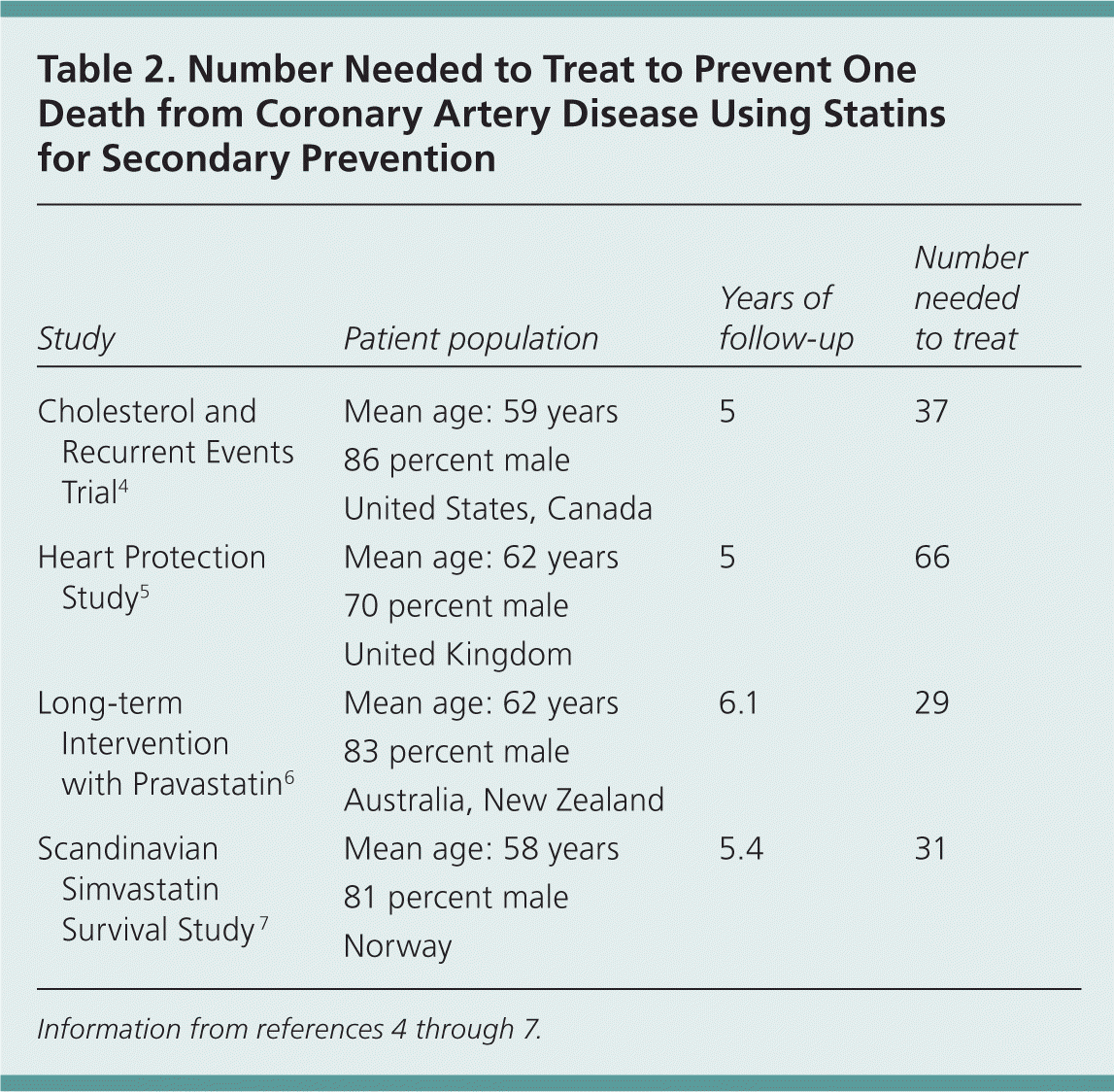
| Study | Patient population | Years of follow-up | Number needed to treat |
|---|---|---|---|
| Cholesterol and Recurrent Events Trial4 | Mean age: 59 years | 5 | 37 |
| 86 percent male | |||
| United States, Canada | |||
| Heart Protection Study5 | Mean age: 62 years | 5 | 66 |
| 70 percent male | |||
| United Kingdom | |||
| Long-term Intervention with Pravastatin6 | Mean age: 62 years | 6.1 | 29 |
| 83 percent male | |||
| Australia, New Zealand | |||
| Scandinavian Simvastatin Survival Study 7 | Mean age: 58 years | 5.4 | 31 |
| 81 percent male | |||
| Norway |
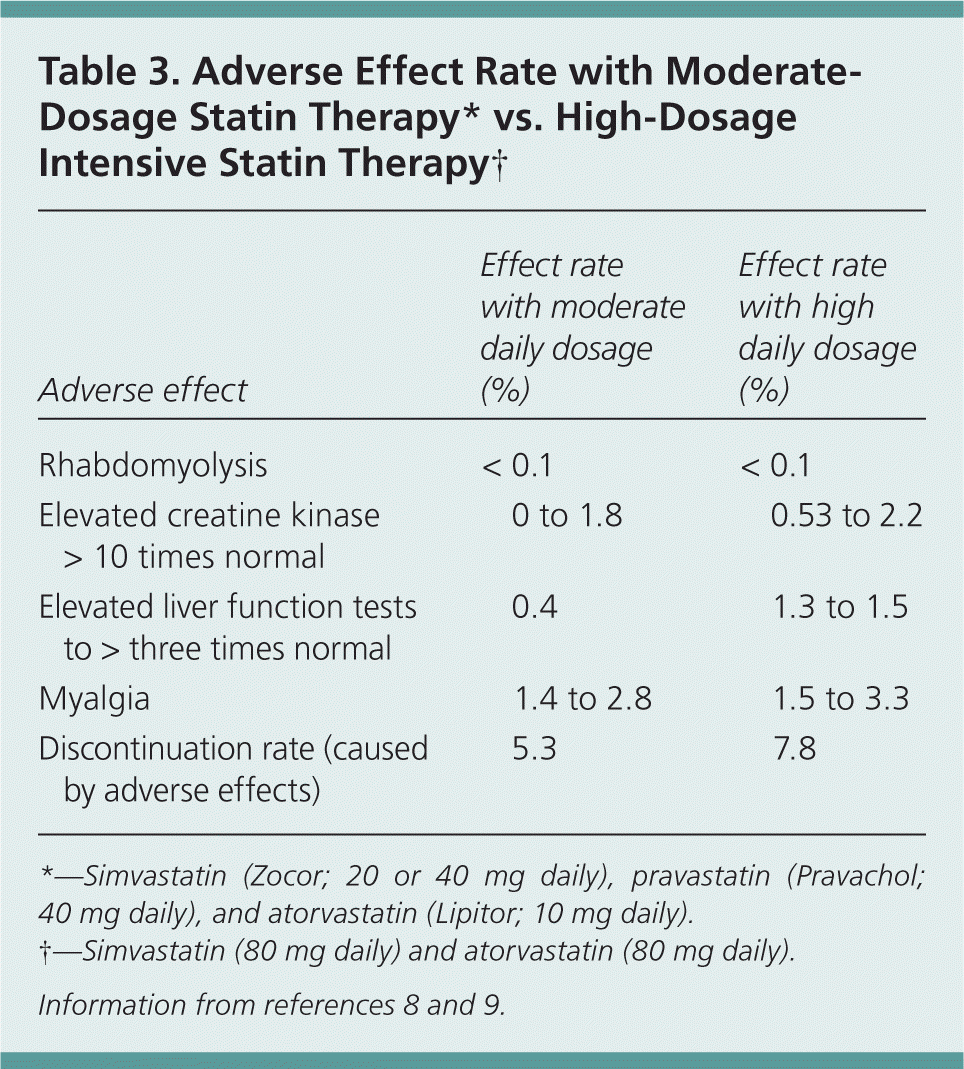
| Adverse effect | Effect rate with moderate daily dosage (%) | Effect rate with high daily dosage (%) |
|---|---|---|
| Rhabdomyolysis | < 0.1 | < 0.1 |
| Elevated creatine kinase> 10 times normal | 0 to 1.8 | 0.53 to 2.2 |
| Elevated liver function tests to > three times normal | 0.4 | 1.3 to 1.5 |
| Myalgia | 1.4 to 2.8 | 1.5 to 3.3 |
| Discontinuation rate (caused by adverse effects) | 5.3 | 7.8 |
Several studies have examined optimal LDL levels in patients with CAD. In one trial, patients given intensive therapy with atorvastatin (Lipitor) in a dosage of 80 mg per day had significantly lower mortality 30 days after MI than those given standard therapy of pravastatin (Pravachol) in a dosage of 40 mg per day (number needed to treat [NNT] = 45 over two years).10 Another study assessed patients with CAD who had an initial LDL level of 130 mg per dL (3.37 mmol per L) or greater and were treated with atorvastatin to a goal of less than 70 mg per dL or less than 100 mg per dL. To avoid the combined outcome of cardiovascular death or MI, the NNT was 30 over five years in favor of the group with a goal of less than 70 mg per dL.11 In addition, a meta-analysis addressed whether a goal of less than 70 mg per dL or less than 100 mg per dL was better, and found that more intensive treatment resulted in an NNT of 20 over one to five years to prevent one MI or cardiovascular death.8
A reduction in LDL cholesterol, regardless of the specific number, is important as well. Another meta-analysis showed that a reduction of at least 40 mg per dL (1.04 mmol per L) yielded a 23 percent decrease in CAD mortality that was sustained over five years.12
Reducing triglyceride levels and increasing high- density lipoprotein (HDL) cholesterol levels also should be considered in the management of CAD. However, these are secondary interventions to incorporate after the LDL goal has been achieved.2,3,13 Nicotinic acid can be added to statin therapy when HDL levels are low or triglyceride levels are above goal. Nicotinic acid prevents the synthesis of very–low-density lipoproteins and LDL, and it alters LDL composition to promote its elimination. Nicotinic acid also raises HDL levels by 15 to 30 percent.2,14 The National Cholesterol Education Program's Adult Treatment Panel III guidelines recommend adding nicotinic acid to statin therapy when triglyceride levels remain above 200 mg per dL (2.26 mmol per L) or HDL cholesterol is less then 40 mg per dL.2
Fibrates also lower non-HDL cholesterol (i.e., total cholesterol minus HDL) and triglyceride levels. Fibrates increase the production of proteins that transport and promote catabolism of fatty acids and triglycerides.14 Evidence supporting the use of fibrates for secondary prevention in patients with CAD has been mixed. Gemfibrozil (Lopid) reduced nonfatal MI and cardiovascular death in patients with CAD (NNT = 22), but bezafibrate was unable to reproduce significant benefits unless triglyceride levels were more than 200 mg per dL.9,15 One study compared fenofibrate (Tricor) and placebo in patients with CAD who were already taking statins, and no difference was detected in cardiovascular outcomes. However, the patients with triglyceride levels higher than 200 mg per dL and HDL levels lower than 35 mg per dL (0.91 mmol per L) after statin therapy did have reduced cardiovascular outcomes with added fenofibrate.13 American Heart Association guidelines recommend adding fibrates if triglyceride levels are 200 mg per dL or higher after a statin trial in patients with CAD.3
Ezetimibe (Zetia) can lower LDL levels in patients who have not achieved their goal despite maximal statin dosing and those in whom statins are not tolerated. However, the effect of ezetimibe on cardiovascular events in patients with CAD has not been studied, and a reduction in intermediate outcomes, such as carotidintima thickness, has not been noted.16
Antihypertensive Agents
The Seventh Report of the Joint National Committee on Prevention, Detection, Evaluation, and Treatment of High Blood Pressure recommends lowering blood pressure to 140/90 mm Hg or less for patients with CAD; however, the American Heart Association recommends a goal of 130/80 mm Hg or less, just as for patients with diabetes or chronic kidney disease.17,18
According to observational studies, for every increase of 20 mm Hg in systolic blood pressure or 10 mm Hg in diastolic blood pressure above the goal of 130/80 mm Hg, the risk of CAD mortality doubles. These data apply to patients 40 to 89 years of age, supporting blood pressure reduction in older patients with hypertension.19 The reduction should be limited to a minimum diastolic pressure of 55 mm Hg.17 Besides reducing blood pressure, antihypertensive drugs improve mortality in patients following MI and can relieve anginal symptoms. Antihypertensive treatment works by decreasing myocardial oxygen demand (which is increased in patients with CAD because of atherosclerosis), lowering left ventricular ejection fraction, and preventing left ventricular hypertrophy.17,18
BETA BLOCKERS
Beta blockers are first-line antihypertensive agents for patients with CAD20; if tolerated, beta blockers are also indicated for patients who do not have hypertension (Table 414 ). These drugs block and β1 and β2 adrenergic receptors, causing a decrease in heart rate, an increase in diastolic filling time, and a decrease in cardiac contractility. This negative inotropic and chronotropic effect decreases myocardial oxygen demand.17 Cardioselective beta blockers, or those that affect only β1 receptors, are preferred to minimize adverse effects, especially the bronchoconstriction that can be caused by beta2 antagonism18,21 (Table 414 ). In one meta-analysis that evaluated beta-blocker therapy in patients with CAD, investigators found a 23 percent reduction in the risk of death (NNT = 42 over two years to avoid one additional death).22 A recent meta-analysis with 464,000 patients confirmed that beta blockers should be first-line therapy in patients with CAD. In the first two years after MI, beta blockers can double the reduction in cardiovascular events compared with all other antihypertensive agents.23 Some beta blockers also possess intrinsic sympathomimetic activity, which can produce an increase in sympathetic activity at rest and may not effectively lower heart rate; these drugs should be avoided18 (Table 414 ).
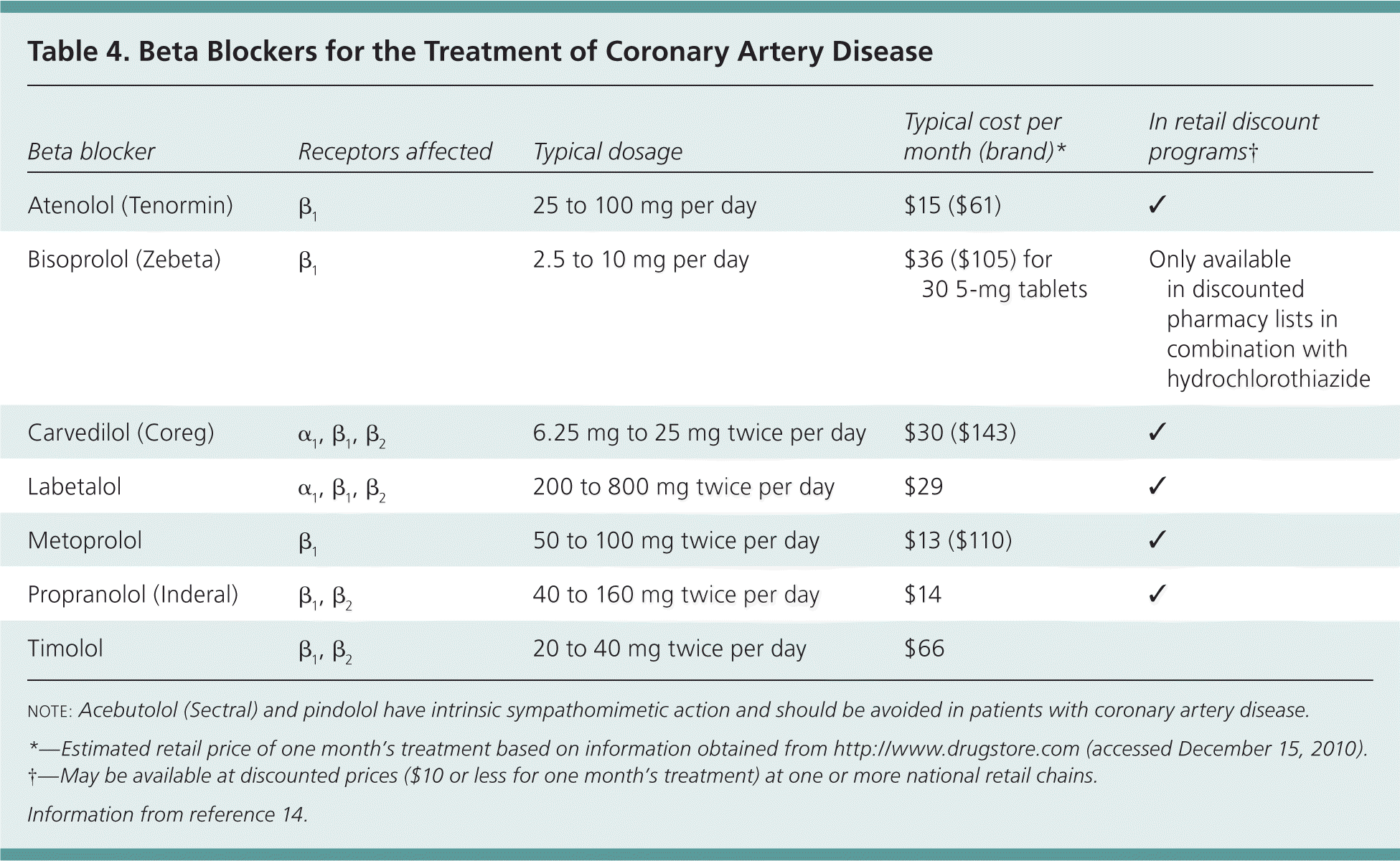
| Beta blocker | Receptors affected | Typical dosage | Typical cost per month (brand)* | In retail discount programs† |
|---|---|---|---|---|
| Atenolol (Tenormin) | β1 | 25 to 100 mg per day | $15 ($61) | ✓ |
| Bisoprolol (Zebeta) | β1 | 2.5 to 10 mg per day | $36 ($105) for 30 5-mg tablets | Only available in discounted pharmacy lists in combination with hydrochlorothiazide |
| Carvedilol (Coreg) | α1, β1, β2 | 6.25 mg to 25 mg twice per day | $30 ($143) | ✓ |
| Labetalol | α1, β1, β2 | 200 to 800 mg twice per day | $29 | ✓ |
| Metoprolol | β1 | 50 to 100 mg twice per day | $13 ($110) | ✓ |
| Propranolol (Inderal) | β1, β2 | 40 to 160 mg twice per day | $14 | ✓ |
| Timolol | β1, β2 | 20 to 40 mg twice per day | $66 |
ANGIOTENSIN-CONVERTING ENZYME INHIBITORS
Angiotensin-converting enzyme (ACE) inhibitors should be used in patients with CAD following MI, those who have diabetes, or those with left ventricular dysfunction. They also should be considered a treatment for hypertension in all other patients with CAD once beta-blocker therapy has been established.3 These agents block the conversion of angiotensin I to angiotensin II, reducing vasoconstriction and peripheral vascular resistance and decreasing blood pressure.14 ACE inhibitors also have cardiovascular benefits by preventing ventricular dilation that can occur in patients following MI.17
In one trial, ramipril (Altace) decreased the likelihood of MI or cardiovascular death (NNT = 27 for four years) compared with placebo in patients with normal left ventricular function.25 In another study, perindopril (Aceon) reduced the risk of cardiovascular death or MI (NNT = 50 over four years).26 Researchers conducting a meta-analysis found that after three years of treatment with ACE inhibitors in patients following MI, cardiovascular mortality was reduced compared with placebo (NNT = 17).27
ANGIOTENSIN RECEPTOR BLOCKERS
Angiotensin receptor blockers (ARBs) are alternatives to ACE inhibitors. ARBs inhibit angiotensin II receptors, thereby decreasing vasoconstriction and the release of aldosterone.14 Although the likelihood of cough is somewhat lower with ARBs than with ACE inhibitors, the risk of other adverse effects is similar.14,24–26
The American Heart Association recommends using ARBs instead of ACE inhibitors only if a patient is intolerant to the latter, because no additional benefit of ARBs has been demonstrated.18 This was confirmed in several trials.18,28–30 One trial compared losartan (Cozaar) and captopril (Capoten) in patients with CAD and found similar outcomes for all-cause mortality and cardiovascular death.28 In the Valsartan in Acute Myocardial Infarction (VALIANT) trial, valsartan (Diovan) was as effective as an ACE inhibitor in reducing mortality rates.29 In addition, the Ongoing Telmisartan Alone and in Combination with Ramipril Global Endpoint Trial (ONTARGET) showed a nonsignificant difference between telmisartan (Micardis) and ramipril in cardiovascular death and nonfatal MI.30 In both ONTARGET and the VALIANT trial, the combination of an ACE inhibitor and an ARB caused more renal adverse effects than an ARB or ACE inhibitor alone and conferred no mortality benefit.29,30
CALCIUM CHANNEL BLOCKERS
Calcium channel blockers are an acceptable alternative if beta blockers are not tolerated, although beta blockers more effectively alleviate anginal symptoms and improve exercise tolerance.24 The two classes of calcium channel blockers are dihydropyridines (i.e., amlodipine [Norvasc], nifedipine [Procardia], and felodipine) and nondihydropyridines (i.e., verapamil and diltiazem [Cardizem]). Both classes cause coronary vasodilation, reduce myocardial oxygen demand, and relieve symptoms of angina.14
One study found that short-acting nifedipine was associated with a dose-related increase in mortality and, therefore, should be avoided. Long-acting calcium channel blockers, however, have a therapeutic role in patients with CAD.31 Another study found that amlodipine reduced cardiovascular events (NNT = 16) compared with placebo, and showed similar improvements in cardiovascular events when compared with enalapril (Vasotec).32 Investigators comparing amlodipine with valsartan found similar cardiovascular outcomes, although amlodipine significantly reduced the risk of heart failure.33
NITRATES
Nitrates can be used when a patient continues to have anginal symptoms despite using a beta blocker, calcium channel blocker, or both. Nitrates relax vascular smooth muscle and primarily cause venodilation, reducing preload and decreasing myocardial oxygen demand.14 Nitrates do not play a role in the treatment of hypertension. Randomized trials evaluating the effects of nitrates on CAD outcomes have not been conducted.
Other antihypertensive drugs and drug classes, such as hydralazine, aldosterone antagonists, and diuretics, should be considered based on comorbidities such as heart failure in patients with CAD. However, these agents will not be discussed further in this article because they have not been found to decrease morbidity and mortality from CAD end points.
Antiplatelet Agents
Antiplatelet therapy is an important component of CAD management because platelet aggregation at atherothrombotic plaque sites can produce clinically significant thrombosis and resultant MI.34 The most common antiplatelet agents used in the United States are aspirin and clopidogrel (Plavix). Aspirin inhibits cyclooxygenase 1 and 2, reducing prostaglandin and thromboxane-A production and preventing platelet aggregation.14 Clopidogrel inhibits adenosine diphosphate receptors, thereby preventing platelet aggregation. Both agents irreversibly inhibit platelet activation.14
The benefit of aspirin in the secondary prevention of CAD is well defined by numerous studies and is reflected in international guidelines.3,35 In the Antithrombotic Trialists' Collaboration Study, researchers demonstrated that patients with a history of MI who were treated with aspirin for a mean of 27 months had fewer nonfatal MIs, strokes, and vascular deaths (NNT = 35).36 A recent meta-analysis further clarified the benefit of aspirin at the dosage range currently recommended by international guidelines, finding that 30 patients needed to be treated for a mean of 33.3 months with aspirin at a dos- age of 50 to 300 mg per day to prevent one cardiovascular event (nonfatal MI, nonfatal stroke, and cardiovascular death). The NNT for individual cardiovascular events was 33 for vascular death, 25 for stroke, 14 for any cause of cardiovascular death, and 12 for nonfatal MI.37
Aspirin is associated with an increased risk of hemorrhagic events.36,37 Data on adverse effects associated with aspirin therapy from long-term prevention trials involving patients with stable CAD are limited.36 In the above meta-analysis, one major hemorrhage occurred for every 111 patients with CAD who took aspirin for a mean of 33.3 months.37
Clopidogrel is approved by the U.S. Food and Drug Administration for the treatment of acute coronary syndrome, recent MI, stroke, and peripheral arterial disease. In a study of patients with a recent MI, there was no benefit of clopidogrel over aspirin in the prevention of fatal or nonfatal cardiovascular events.38 In another trial, patients deemed to be at high risk of atherothrombotic events were randomized to aspirin (75 to 162 mg per day) plus clopidogrel (75 mg per day) or aspirin alone. No difference in cardiovascular events was found except for a reduction in ischemic stroke, with an increased risk of bleeding in the treatment group.39 Thus, except for the significant benefit clopidogrel may provide following acute coronary syndrome or stent placement, it should not be added to aspirin therapy in patients with stable CAD to prevent future MI.
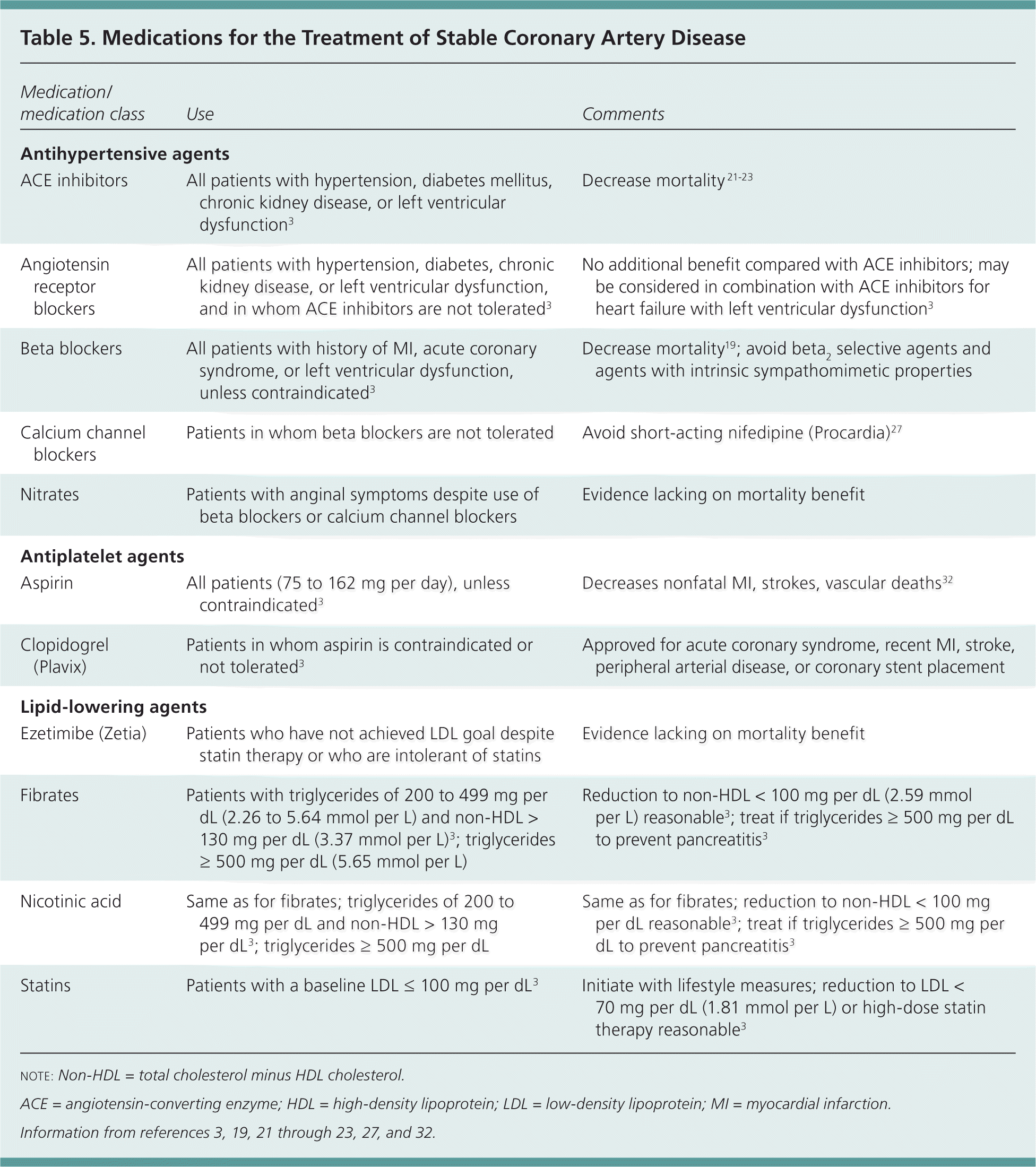
| Medication/medication class | Use | Comments |
|---|---|---|
| Antihypertensive agents | ||
| ACE inhibitors | All patients with hypertension, diabetes mellitus, chronic kidney disease, or left ventricular dysfunction3 | Decrease mortality 21–23 |
| Angiotensin receptor blockers | All patients with hypertension, diabetes, chronic kidney disease, or left ventricular dysfunction, and in whom ACE inhibitors are not tolerated3 | No additional benefit compared with ACE inhibitors; may be considered in combination with ACE inhibitors for heart failure with left ventricular dysfunction3 |
| Beta blockers | All patients with history of MI, acute coronary syndrome, or left ventricular dysfunction, unless contraindicated3 | Decrease mortality19; avoid beta2 selective agents and agents with intrinsic sympathomimetic properties |
| Calcium channel blockers | Patients in whom beta blockers are not tolerated | Avoid short-acting nifedipine (Procardia)27 |
| Nitrates | Patients with anginal symptoms despite use of beta blockers or calcium channel blockers | Evidence lacking on mortality benefit |
| Antiplatelet agents | ||
| Aspirin | All patients (75 to 162 mg per day), unless contraindicated3 | Decreases nonfatal MI, strokes, vascular deaths32 |
| Clopidogrel (Plavix) | Patients in whom aspirin is contraindicated or not tolerated3 | Approved for acute coronary syndrome, recent MI, stroke, peripheral arterial disease, or coronary stent placement |
| Lipid-lowering agents | ||
| Ezetimibe (Zetia) | Patients who have not achieved LDL goal despite statin therapy or who are intolerant of statins | Evidence lacking on mortality benefit |
| Fibrates | Patients with triglycerides of 200 to 499 mg per dL (2.26 to 5.64 mmol per L) and non-HDL > 130 mg per dL (3.37 mmol per L)3; triglycerides ≥ 500 mg per dL (5.65 mmol per L) | Reduction to non-HDL < 100 mg per dL (2.59 mmol per L) reasonable3; treat if triglycerides ≥ 500 mg per dL to prevent pancreatitis3 |
| Nicotinic acid | Same as for fibrates; triglycerides of 200 to 499 mg per dL and non-HDL > 130 mg per dL3; triglycerides ≥ 500 mg per dL | Same as for fibrates; reduction to non-HDL < 100 mg per dL reasonable3; treat if triglycerides ≥ 500 mg per dL to prevent pancreatitis3 |
| Statins | Patients with a baseline LDL ≤ 100 mg per dL3 | Initiate with lifestyle measures; reduction to LDL < 70 mg per dL (1.81 mmol per L) or high-dose statin therapy reasonable3 |
